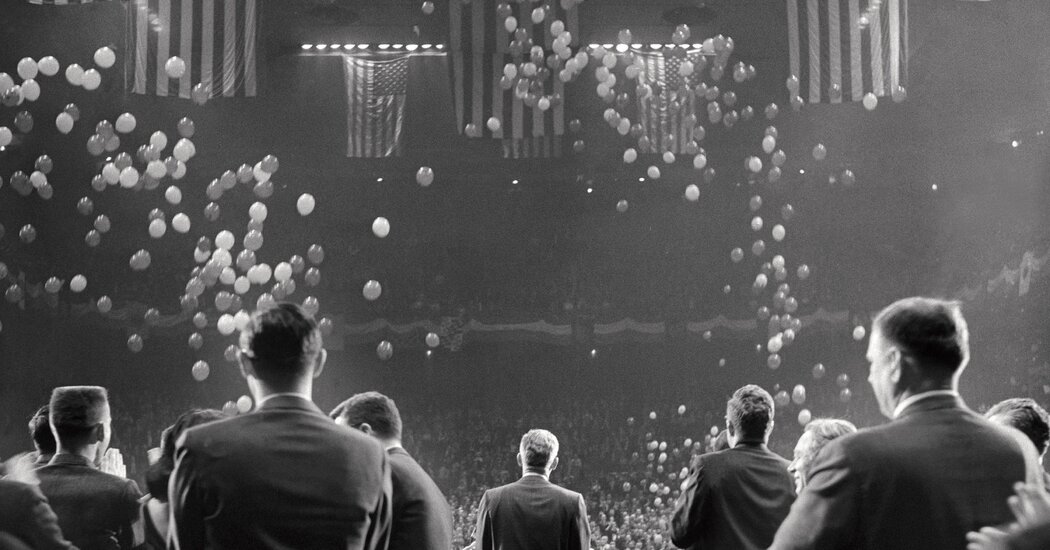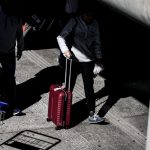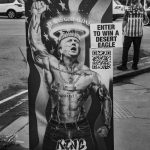

Madison Square Garden, where Donald J. Trump and his running mate, JD Vance, are scheduled to hold a fund-raiser and rally on Sunday, has a long history of political events. Some have been peaceful. Some have not.
It is where Marilyn Monroe sang “Happy Birthday, Mr. President” to a 45-year-old John F. Kennedy in May 1962, her dress lit so that it became see-through, and where Bill Clinton followed his acceptance speech at the 1992 Democratic National Convention with Fleetwood Mac’s “Don’t Stop.” It is where President Franklin D. Roosevelt in 1936 gave one of his most important speeches and signaled a turn toward more openly combative campaigning.
Calling his opponents in the banking and military industries “enemies of peace,” Roosevelt sounded a note that is now eerily familiar: “Never before in all our history have these forces been so united against one candidate as they stand today,” he told the crowd. “They are unanimous in their hate for me — and I welcome their hatred.”
But much of the commentary this weekend can be expected to focus on another historical antecedent, from 1939, when more than 20,000 people, many wearing Nazi armbands, filled the Garden for a “Pro America Rally” in support of Adolf Hitler. The Garden was then at its third of four locations, at 50th Street and Eighth Avenue.
Mr. Trump’s rally comes just days after John F. Kelly, his longest-serving chief of staff, said that the former president fit the definition of a fascist. Mr. Trump, on his Truth Social platform, called Mr. Kelly a “total degenerate” and “LOWLIFE.”
At the 1939 rally, at least 10,000 protesters packed the streets, kept away from the arena by a record 1,700 policemen. “We have enough police here to stop a revolution,” the police commissioner, Lewis J. Valentine, said.
Inside, on a stage draped with Nazi banners, red, white and blue bunting and a 30-foot portrait of George Washington, speakers railed against the “Jewish-controlled press” and referred to the president as Franklin “Rosenfeld.” One approvingly called Washington “America’s first fascist.”
When a Jewish man named Isidore Greenbaum tried to mount the stage, he was tackled by members of the gray-shirted German American Bund, a pro-Hitler group that organized the rally, who handed him over to the police.
Attendees paid 40 cents to $1.10 to enter.
Mayor Fiorello La Guardia defended his decision to allow the pro-Nazi group to gather, citing free speech laws, and he played down several bomb threats called in to the arena. “If they bomb it, we’ll catch the bombers,” he said.
Other divisive groups followed. The Communist Party filled the Garden for its convention in 1940, followed a year later by the right-wing America First Committee, led by the aviator Charles Lindbergh, who denounced the press as “contemptible” and “dishonest parasites.”
In 1943, 40,000 people attended two performances at the Garden by Hollywood and Broadway stars called “We Will Never Die,” created to call attention to the slaughter of European Jews.
Republican presidential campaigns often skip public rallies in New York, viewing the state as reliably Democratic. (An exception: Barry Goldwater, the party’s standard-bearer in 1964, spoke to a Garden crowd of 18,000 at a Young Americans for Freedom rally and received a 28-minute ovation; he went on to lose the state by 37 percentage points.)
But Mr. Trump made his name in New York and has said, contrary to polls, that he will carry the state. He made an appearance in the South Bronx in May — his first rally in the state in eight years — where a racially diverse crowd applauded his anti-migrant remarks and chanted “Build the wall.”
Although Mr. Trump said he had worried about how the Bronx crowd would receive him, only about 100 protesters turned out. Mr. Trump declared the day a “love fest.” He returned to the borough this month to speak at a barbershop.
Yet New York, and the Garden, have been particularly hostile territory for the former president. He lost the state by 23 percentage points in 2016 and 2020. And while he has gotten favorable legal rulings in other states, New York courts have handed him 34 felony convictions and slapped him with judgments of $83 million for defaming the writer E. Jean Carroll and $355 million plus interest for fraud.
In 2019, when he attended an Ultimate Fighting Championship event at the Garden, he received a robust round of boos along with some cheers.
Tensions will probably be higher for a political rally just nine days before the election, especially given the ferocity of campaign rhetoric and two attempts to assassinate Mr. Trump. The visit comes as New York City’s government and Police Department have been roiled by several high-level resignations.
A rally in Harlem for Vice President Kamala Harris, the Democratic nominee, in August, shortly before the Democratic National Convention, reflected the more confrontational climate. Pro-Palestinian demonstrators outnumbered Harris supporters, clashed with the police and interrupted speakers supporting Ms. Harris several times (she and her running mate, Gov. Tim Walz, were not there). The police detained 14 protesters.
For Mr. Trump’s rally on Sunday, which is a fund-raiser, top donors are offered an “Ultra MAGA Experience” for $924,600.
George Conway, a Republican who is highly critical of Mr. Trump, urged his 2.3 million followers on X to sign up to attend the rally.
The police will close the area around the Garden to pedestrians and screen people entering the arena. As of Thursday, the department said it had received no credible threats of planned disturbances but was on heightened alert.
Representatives of local and federal law enforcement agencies met on Friday to discuss security measures related to the event, including additional police officers in and around the arena, at Pennsylvania Station and in the subway.
The Police Department said in a statement that it would “deploy an array of resources to this location for the event this weekend. We are in constant contact with the venue regarding specific security needs.”
Aaron Donovan, Metropolitan Transportation Authority spokesman, said the transit system was used to large crowds.
“It’s New York,” he said. “There are special events all the time, all over the region.”
Asked how he planned to spend Sunday night, Mayor Eric Adams said, “Meditate.”
Close to mind will be the 2004 Republican National Convention, which was held at the Garden. The police arrested more than 1,800 demonstrators around town, and the city ultimately paid $18 million for civil rights violations. Legal fees cost the city an additional $16 million.
Mr. Trump’s rally comes almost exactly a century after the Garden’s most chaotic political event, the 1924 Democratic Convention, where the party, fiercely divided over immigration and other issues, took 16 days and 103 votes to pick a candidate.
Fistfights broke out on the convention floor and on the streets. As the convention dragged on, 20,000 Ku Klux Klan members and their relatives marched in New Jersey to support a leading candidate, Senator William G. McAdoo of California.
The party ultimately nominated Jonathan Davis, who lost to Calvin Coolidge in a landslide.
For the Garden, in its various incarnations, a century of politically tumultuous events was just beginning.
The post Presidents, Conventions and Nazis: A Political History of ‘The Garden’ appeared first on New York Times.



